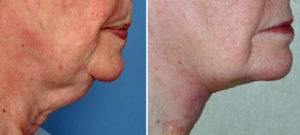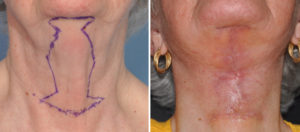Background: Aging of the face creates a variety of well known soft tissue sagging effects. One of the most recognized, and usually a later manifestation of the aging process, is that of the turkey neck. The tissues from the central and sides of the neck drop down and the gathering in the middle creates the classic wattle which can present in many varying degrees.
The classic and standard treatment for such aging neck conditions is the lower facelift. Using tissue elevation and pull back up towards and around the ears, the loose neck tissues are essentially redistributed to a place where it is more favorable from a scar standpoint for them to be removed. In reality the hanging neck tissues are largely pulled back from whence they came using the face and upper neck tissues as the reins to do so.
While a lower facelift is very effective at addressing the aging neck, there are some patients who simply do not want to undergo it. Issues such as cost, extent of the surgery, recovery, medical reasons and lack of good scar camouflage around the ears keep certain patients from having the surgery. An uncommon alternative to a lower facelift is the direct neck lift. By directly attacking the problem where it is the greatest (central neck) the greatest reduction and uplifting of the neck is done. The question always is how bad is the scar and is it worth it?
Case Study: This 76 year-old female had a a major turkey neck but did want to have a full lower facelift. She opted for a direct neck lift and was less concerned about the scar than she was about more major surgery.


In my experience the direct neck lift can be a good option in some older men (greater than age 65) due to the good healing properties of beard skin. I have done a few older women (age 75 and older) whose final scar outcome was also favorable. Thin crepey neck skin scars the best in women who opt for this approach to their turkey neck.
Case Highlights:
1) The direct neck lift offers a complete excision of the turkey neck deformity by removal of skin and fat and muscle plication.
2) The midline neck scar is the lone drawback to a direct turkey neck excision.
3) Men do better with a midline neck scar due to beard skin but women can be similarly treated.
Dr. Barry Eppley
Indianapolis, Indiana



